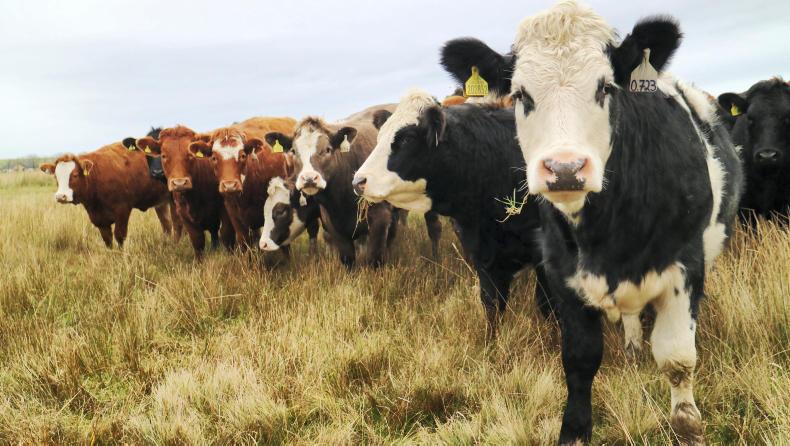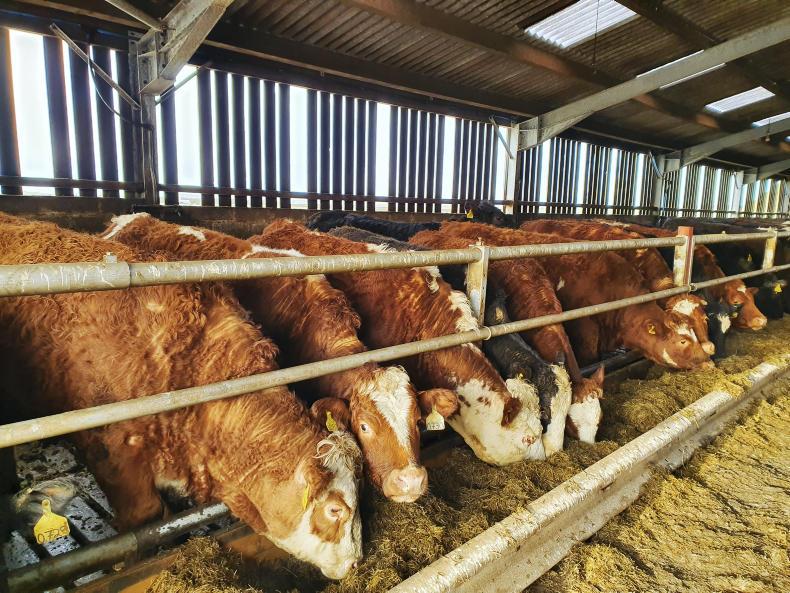Mark and Shona Mackay at Greenvale have the furthest farm north in the project, sitting a stone’s throw from Dunnet Head the most northern point of Britiain.
They run 160 suckler cows on 360ha. The cows are run as two separate groups, with around 100 calving in the spring and a further 60 calving in the summer.
Spring herd output £928/cow
The spring cows start calving in the first days of March and since long before the project, Mark has kept them to a strict eight weeks.
This means that cows are housed through the winter and turned out to grass as they calve. This keeps the feed costs of the spring cows down as they are only being fed a dry cow ration in the shed.

In-calf heifers at Greenvale farm at Caithness.
Once at grass, the cows go on to a grazing rotation. Rotational grazing has been one of the keys to improving performance at Greenvale, with calves being weaned at higher weights than they were before the project.
Mark has also been strict on cow production over the years and weaning rates for the spring herd have averaged 94% over the life of the project, peaking at 98% last year.

The Mackays feeding their housed cows in winter.
Combining these factors, the output per cow has risen by £110 from £812 in 2016 to £928 in 2019.
The Mackays have always kept a close eye on costs in the business. However, they still managed to reduce feed costs per cow by £12 between 2016 and 2019.
The vet bill has also fallen by £24/cow. However, other livestock expenses have risen over the period, leading to total variable costs falling by £8/cow.
Forage costs falling £67/cow
Forage costs have also fallen by £67 thanks to better grassland utilisation, meaning the spring herd has seen the gross margin per cow rise by £191.
Coupling this with a 46% rise in stocking rate, the spring herd has achieved a near doubling in the gross margin per hectare, rising by £171 from £177/ha to £348/ha.
Silage quality improvement
Greenvale has a significant area of the farm committed to the Agri Environment Climate Scheme. Much of this is on the grassland, with wading birds being the focus.
This means that silage cannot be cut until 1 July, having been closed up on 1 April.
Previously, this meant that silage quality was low, reducing the growth rate of the calves.

The Mackays believe that better grassland management has pushed their herd's performance.
Since the beginning of the project, the silage ground was grazed hard through the month of March, meaning that by the time it was closed in April, it took some time to recover.
This means that come 1 July, the grass is not as mature, leading to better quality silage, with a lift of around 0.5MJME over previous samples.
Summer herd output £838/cow
The summer cows also show a similar improvement in performance. Weaning rates have risen from 78% at the start of the project in 2016 to 93% achieved in 2019.
Most of the summer calves had been previously sold store at 10 to 12 months old.

The weaning weight for calves has risen from 330kg to 424kg.
However, with the increase in stocking rate and grass utilisation, the lighter ones are now kept on for the summer, putting on cheap kilos at grass.
This has seen calf sale weights rise by 93kg from an average of 330kg to 424kg. The fall in the beef price has also affected Greenvale, with the price per kg paid for the calves falling by 33p to £2.11/kg.
Thanks to the improvement in weaning rate, the output per cow has risen by £230 over 2016 to £838.

Mackays' cattle on slats.
While the summer herd was already a low-input herd, the Mackays’ focus on costs meant that they managed to shave a further £27/cow off the variable costs, reducing them to £165/cow.
With the same reduction in forage costs as the spring herd, the gross margin per cow in the summer group has risen by £314 from £292/cow to £672/cow.
When this is paired with a 24% increase in stocking rate, the summer cows have more than doubled their gross margin per hectare from £134/ha to £376/ha.
Mark and Shona Mackay at Greenvale have the furthest farm north in the project, sitting a stone’s throw from Dunnet Head the most northern point of Britiain.
They run 160 suckler cows on 360ha. The cows are run as two separate groups, with around 100 calving in the spring and a further 60 calving in the summer.
Spring herd output £928/cow
The spring cows start calving in the first days of March and since long before the project, Mark has kept them to a strict eight weeks.
This means that cows are housed through the winter and turned out to grass as they calve. This keeps the feed costs of the spring cows down as they are only being fed a dry cow ration in the shed.

In-calf heifers at Greenvale farm at Caithness.
Once at grass, the cows go on to a grazing rotation. Rotational grazing has been one of the keys to improving performance at Greenvale, with calves being weaned at higher weights than they were before the project.
Mark has also been strict on cow production over the years and weaning rates for the spring herd have averaged 94% over the life of the project, peaking at 98% last year.

The Mackays feeding their housed cows in winter.
Combining these factors, the output per cow has risen by £110 from £812 in 2016 to £928 in 2019.
The Mackays have always kept a close eye on costs in the business. However, they still managed to reduce feed costs per cow by £12 between 2016 and 2019.
The vet bill has also fallen by £24/cow. However, other livestock expenses have risen over the period, leading to total variable costs falling by £8/cow.
Forage costs falling £67/cow
Forage costs have also fallen by £67 thanks to better grassland utilisation, meaning the spring herd has seen the gross margin per cow rise by £191.
Coupling this with a 46% rise in stocking rate, the spring herd has achieved a near doubling in the gross margin per hectare, rising by £171 from £177/ha to £348/ha.
Silage quality improvement
Greenvale has a significant area of the farm committed to the Agri Environment Climate Scheme. Much of this is on the grassland, with wading birds being the focus.
This means that silage cannot be cut until 1 July, having been closed up on 1 April.
Previously, this meant that silage quality was low, reducing the growth rate of the calves.

The Mackays believe that better grassland management has pushed their herd's performance.
Since the beginning of the project, the silage ground was grazed hard through the month of March, meaning that by the time it was closed in April, it took some time to recover.
This means that come 1 July, the grass is not as mature, leading to better quality silage, with a lift of around 0.5MJME over previous samples.
Summer herd output £838/cow
The summer cows also show a similar improvement in performance. Weaning rates have risen from 78% at the start of the project in 2016 to 93% achieved in 2019.
Most of the summer calves had been previously sold store at 10 to 12 months old.

The weaning weight for calves has risen from 330kg to 424kg.
However, with the increase in stocking rate and grass utilisation, the lighter ones are now kept on for the summer, putting on cheap kilos at grass.
This has seen calf sale weights rise by 93kg from an average of 330kg to 424kg. The fall in the beef price has also affected Greenvale, with the price per kg paid for the calves falling by 33p to £2.11/kg.
Thanks to the improvement in weaning rate, the output per cow has risen by £230 over 2016 to £838.

Mackays' cattle on slats.
While the summer herd was already a low-input herd, the Mackays’ focus on costs meant that they managed to shave a further £27/cow off the variable costs, reducing them to £165/cow.
With the same reduction in forage costs as the spring herd, the gross margin per cow in the summer group has risen by £314 from £292/cow to £672/cow.
When this is paired with a 24% increase in stocking rate, the summer cows have more than doubled their gross margin per hectare from £134/ha to £376/ha.











 This is a subscriber-only article
This is a subscriber-only article










SHARING OPTIONS: